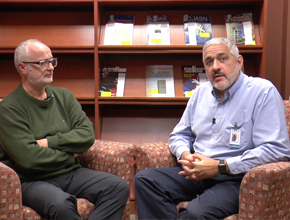References
Colorectal Cancer Screening. Cancer Care Ontario. https://www.cancercare.on.ca/pcs/screening/coloscreening/?WT.mc_id=/colorectalscreening. Accessed July 7, 2017.Roman Jaeschke: Two issues: one is the fecal immunochemical test (FIT). Could you elaborate on this? I hear that the guaiac test is being moved away from and the FIT test is coming.
David Morgan: Many other provinces in [Canada], other than Ontario, already have moved from guaiac testing to the FIT test. Guaiac testing is basically enzyme conversion, which detects an element of the human hemoglobin. It will also detect other hemoglobins, so if you eat a raw steak, your guaiac test may be positive. If you take a number of different types of vegetables that have the same plant enzyme that makes the same conversion as on the cards, you can get a positive test. The testing is dependent on how the patients are told to do it. You need to tell them about dietary restrictions, what you should avoid doing, and all sorts of things.
You do not have to do dietary restrictions with FIT, so right off the top that is an advantage for the patient. You do not have to do as many samples, you can get away with a single sample. People generally do not like dealing with poop and they do not like having to smear poop onto a card, so to be able to take a tube and dip it into a piece of poop and send the tube back is much more acceptable. We have seen that particularly in Alberta: the rate of screening went up dramatically when FIT was…
Roman Jaeschke: Dramatically meaning from what to what, roughly?
David Morgan: More than 20% over about a 4-month period…
Roman Jaeschke: In absolute terms, so 20% more of the population was screened.
David Morgan: Yes. And at the same time, people saw that the results were very positive, so things like average-risk colonoscopy referrals went down in the clinic almost in direct parallel to the increase in the FIT tests that were done. People were much more comfortable in doing the test, they were comfortable in the results that they were getting back, that was being higher percentage. In Ontario, we are probably going to double the sensitivity from what we see with guaiac testing. You would expect now about 4% of people who do a guaiac test will be positive. With the FIT test you can actually determine the level of sensitivity that you use in the qualitative measurements, and we are looking at probably around 7.5%, so around twice as many people will be detected…
Roman Jaeschke: As having a positive test result, which means they would need to undergo further procedures. Once you have the stool for the occult blood, guaiac, or FIT testing, what is your probability of actually having polyps or cancers or coming up clean?
David Morgan: Again, among that 4% positive test results, many of those will be false positives because of dietary changes, many of them will be positive because of things like hemorrhoids. It is still a positive test, but it is not going to prevent you from having colon cancer, for example. You would normally expect to have colon cancers at colonoscopy of between 1% and 2% of your patients that you are examining. When we do the FIT test, from Calgary we have seen that the number of findings, particularly big polyps but also of colon cancers, has gone up in a very short period of time. So if you are positive in a FIT test, you are much more likely to have something that is truly significant and you are much more likely to have that found if you go on to colonoscopy.
Roman Jaeschke: So it is not only a more sensitive test, we do more colonoscopies as a result of positive test results, but it also has a higher predictive value. So it sounds like a win-win situation.
David Morgan: It is win-win and one of the concerns from that is what you just said, that there will be potentially more colonoscopies and more colonoscopies that are going to have to have things done, so you are going to have big polyps that you will have to take out or you will find cancers that require surgery. There will be more work for the pathologists because you are going to have more samples. More materials are generated.
Roman Jaeschke: But there will be fewer negative colonoscopies if these colonoscopies were done for screening purposes.
David Morgan: Yes, and what they saw in Calgary, for example, was that the number of average-risk screening colonoscopies went down significantly, which was a good thing, because you have to put all these positive FIT people somewhere. They were able to keep the resources pretty much the same.
Roman Jaeschke: David, if you were to look into the next 5 to 10 years and you were on the panels deciding what the screening will be, what would be your prediction? Off the record.
David Morgan: In the short term, the FIT tests are certainly going to be Canada-wide, I would expect. I do not know about 10 years, but certainly in 20 years I think things will be very different. I suspect that the way that we do colonoscopy will be very different. I can envision a model where there will be nurses or technicians – it is already done in some parts of the world – where they will be the ones doing colonoscopies, as opposed to gastroenterologists. We are already seeing a change in endoscopic retrograde cholangiopancreatographies (ERCPs), for example, where you are not doing ERCPs for diagnosis – you are doing therapeutic interventions with ERCP. I suspect there will be some of that with colonoscopies as well.
I think there will be other tests and what would be really nice would be if you could do a blood test, for example, and it would tell you what your risk of having significant polyps would be. Many of the adenomas we find do not become cancers; many people have adenomas and we have no way at the moment of detecting and telling whether or not that is going to progress, so we take them all out but that may not be what we need to do. I think we will see changes. Is it going to be in my lifetime? No, I doubt it, but certainly in the next generation…
Roman Jaeschke: We are still young.
David Morgan: But not as young as we were.
Roman Jaeschke: No, it is getting worse. The last question, again off the record. If your colleague, of average age, would come to you and say, “Hey, David, I know that you know something about screening, what should I do?”
David Morgan: The first thing is, you have to do something. If you go by the Cancer Care Ontario guidelines, I would say next year you should have a FIT test done. What happens in the real world amongst physicians is that many people get colonoscopies instead, and the guidelines from the Canadian Association of Gastroenterology have not said that you cannot have a colonoscopy after the age of 50. They call that opportunistic screening, as opposed to programmatic screening, as I mentioned a little bit earlier. Part of the problem is we do not know that colonoscopy is the best test; it may well be. At the moment, we cannot offer the test to everyone – which is what we want – in a program-based screening. There is nothing that is stopping people in Ontario from getting that done. Not everywhere in the country is the same. For example, in some of the Maritime provinces they do not offer codes for average-risk screening. So it is not the same. Even in a 2004 paper, we said you should choose your screening on the basis of your preferences and availability of resources.
Roman Jaeschke: That is the last question, I promise. We are talking about Ontario, Hamilton, Canada. As much as you know, across the world, are there any significant differences in this variability about which you were talking?
David Morgan: There is definitely variability in terms of your risk. In terms of what people consider to be the best range for screening, there is very little difference. Pretty much all the guidelines, whether European or North American, suggest that you should get screened between either 50 and 75 or 74 years; there is couple of European countries where they dropped down to 70 years, but that window seems to be the biggest bang for the buck and if you look at the polyps and the cancer risks, the curve starts to really take off around 50 years and then probably will plateau by the time you get to about age 85. Once you are 85 years old, you probably do not need to do anything. The likelihood of you dying from colon cancer is very low, the likelihood of dying from something else is much, much higher. I do not think there is a big variability that way. There is variability in terms of the programs. We are certainly seeing FIT being much more widely used across the world and there are areas where colonoscopy is used to varying degrees too.
Roman Jaeschke: I hope it will help our listeners to choose their own test and the test for their patients. Thank you very much. We will get an update in a few years.
David Morgan: We will see where it goes. Thanks.
 English
English
 Español
Español
 українська
українська




